BUICK CENTURY 1996 Owners Manual
Manufacturer: BUICK, Model Year: 1996, Model line: CENTURY, Model: BUICK CENTURY 1996Pages: 340, PDF Size: 17.61 MB
Page 171 of 340
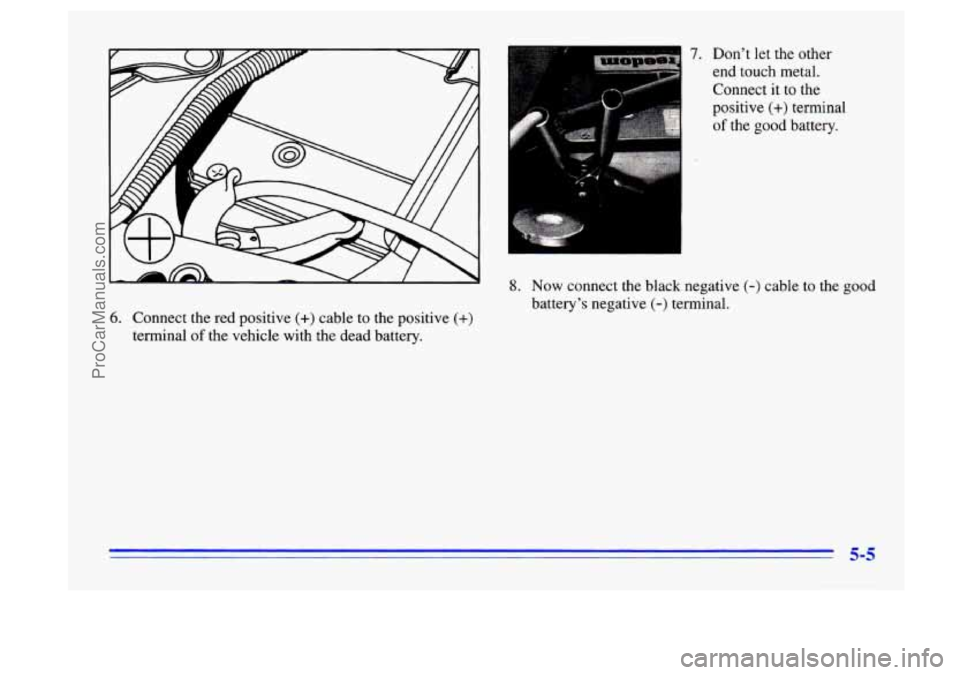
6. Connect the red positive (+) cable to the positive (+)
terminal of the vehicle with the dead battery. Don’t let the
other
end touch metal.
Connect it
to the
positive
(+) terminal
of the good battery.
8. Now connect the black negative (-) cable to the good
battery’s negative
(-) terminal.
5-5
ProCarManuals.com
Page 172 of 340
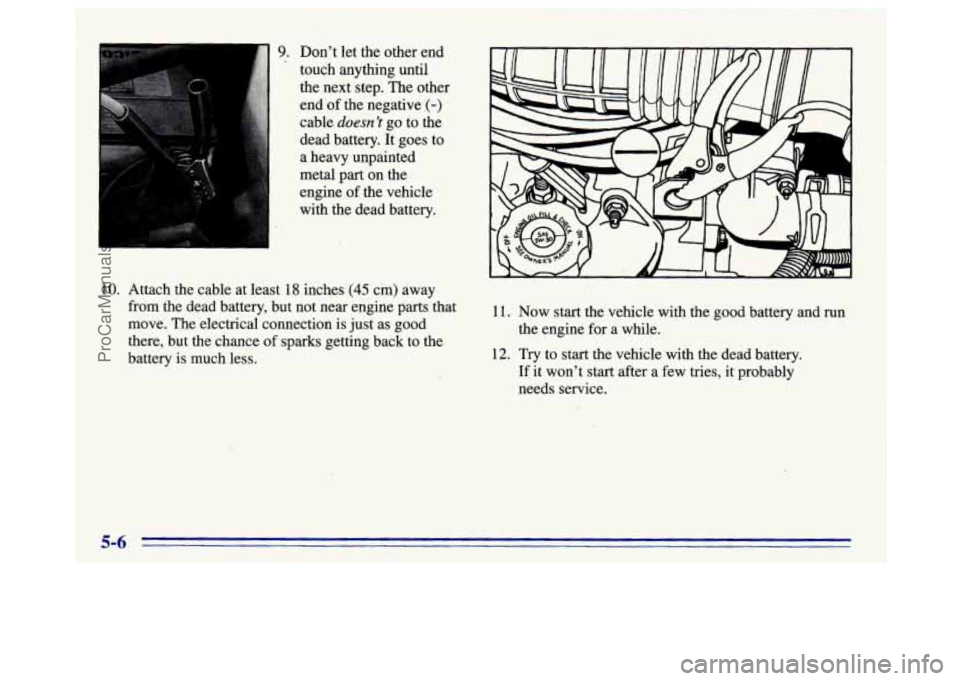
9. Don't let the other end
touch anything until
the next step. The other
end of the negative
,(-)
cable doesn't go to the
dead battery. It goes to
a heavy unpainted
metal part on the
engine
of the vehicle
with the dead battery.
10. Attach the cable at least 18 inches (45 cm) away
from the dead battery, but not near engine parts that
move. The electrical connection is just as good
there, but the chance of sparks getting back to the
battery is much less.
11 .. Now start the vehicle with the good battery and run
12. Try to start the vehicle with the dead battery.
the engine
for a
while.
If it won't start after a few tries, it probably
needs service.
5-6
ProCarManuals.com
Page 173 of 340
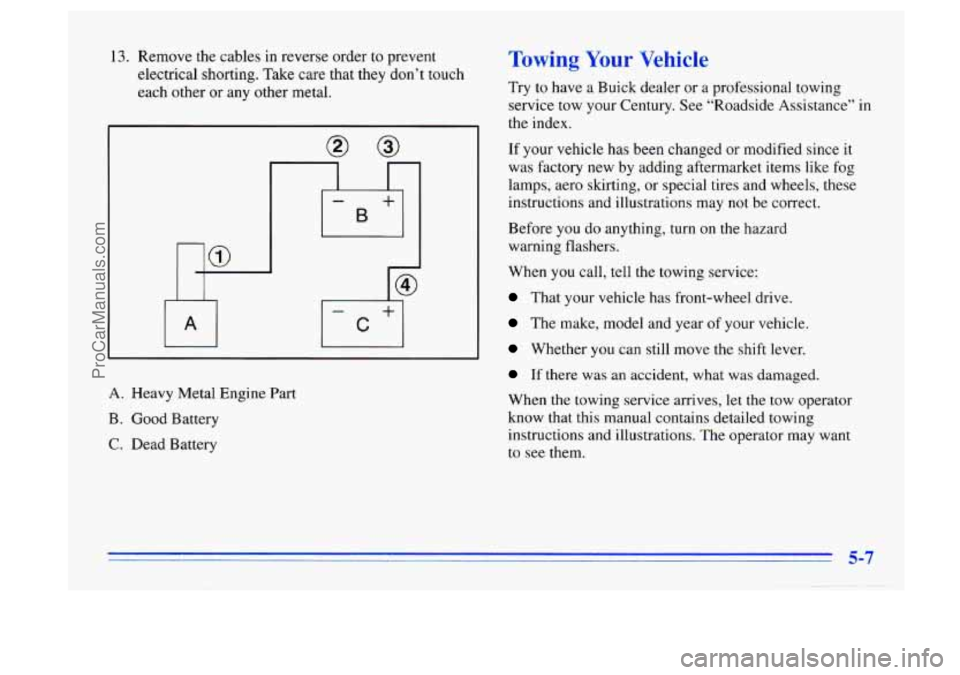
13. Remove the cables in reverse order to prevent
electrical shorting. Take care that they don’t touch
each other
or any other metal.
A. Heavy Metal Engine Part
B. Good Battery
C. Dead Battery
Towing Your Vehicle
Try to have a Buick dealer or a professional towing
service tow your Century. See “Roadside Assistance” in
the index.
If your vehicle has been changed or modified since it
was factory new by adding aftermarket items like fog
lamps, aero skirting, or special tires and wheels, these
instructions and illustrations may
not be correct.
Before you do anything, turn on the hazard
warning flashers.
When you call, tell the towing service:
That your vehicle has front-wheel drive.
The make, model and year of your vehicle.
Whether you can still move the shift lever.
If there was an accident, what was damaged.
When
the towing service arrives, let the tow operator
know that this manual contains detailed towing
instructions and illustrations. The operator may want
to see them.
ProCarManuals.com
Page 174 of 340

To help avoid injury to you or others:
Never let passengers ride in a vehicle that is
0 Never tow faster than safe or posted speeds.
0 Never tow with damaged parts not
fully secured.
Never get under your vehicle after it has
been lifted by the tow truck.
Always secure the vehicle on each side with
separate safety chains when towing it.
0 Never use J-hooks. Use T-hooks instead.
being
towed.
U
A vehicle can fall from a car carrier if it isn’t
adequately secured. This can cause
a collision,
serious personal injury and vehicle damage. The
vehicle should be tightly secured with chains or
steel cables before it is transported.
Don’t use substitutes (ropes, leather straps,
canvas webbing, etc.) that can be cut by sharp
edges underneath the towed vehicle.
Always use
T-hooks inserted in the
T-hook slots. Never use
J-hooks. They will damage drivetrain and
suspension components.
When your vehicle
is being towed, have the ignition
key
in the OFF position. The steering wheel should
be clamped
in a straight-ahead position, with a
clamping device designed for towing service. Do not
use the vehicle’s steering column lock for this. The
transaxle should be in NEUTRAL (N) and the
parking brake released.
5-8
ProCarManuals.com
Page 175 of 340
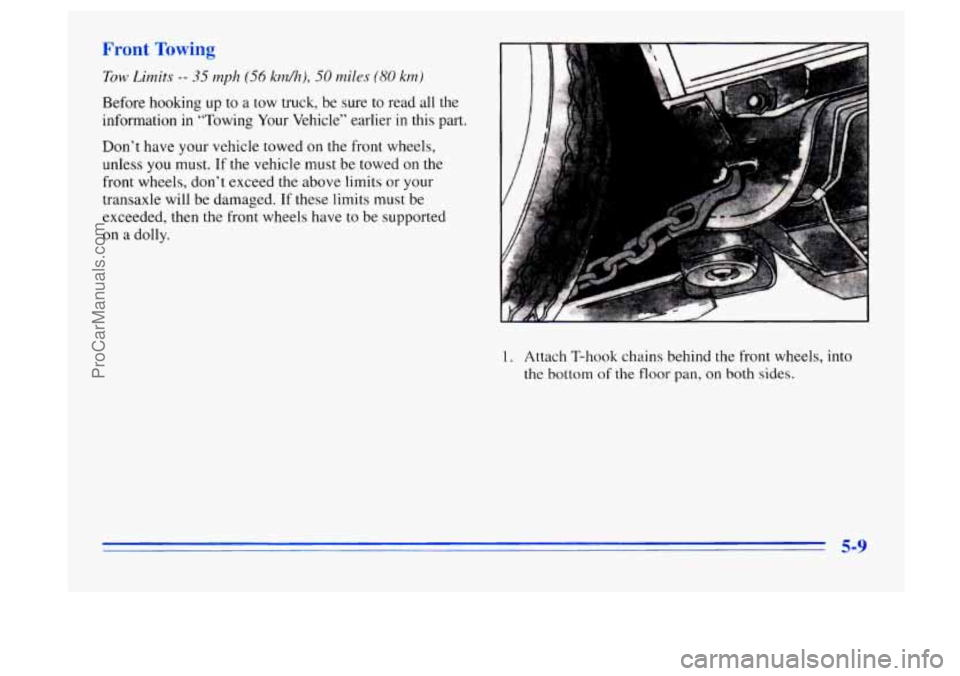
Front Towing
Tow Limit,s -- 35 mph (56 krn/h), 50 miles (80 km)
Before hooking up to a tow truck, be sure to read all the
information in “Towing Your Vehicle” earlier in this part.
Don’t have your vehicle towed on the front wheels,
unless you must. If the vehicle must be towed on the
front wheels, don’t exceed the above limits or your
transaxle will be damaged. If these limits must be
exceeded, then the front wheels have to be supported
on
a dolly.
1. Attach T-hook chains behind the front wheels, into
the bottom of the floor pan, on both sides.
5-9
ProCarManuals.com
Page 176 of 340
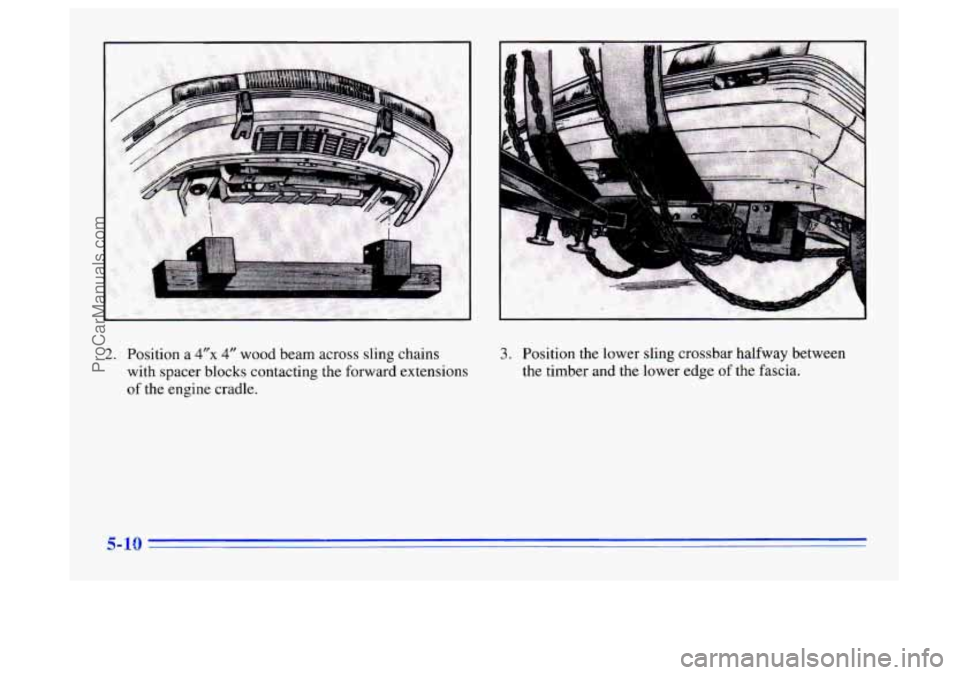
2. Position a 4”x 4” wood beam across sling chains
with spacer blocks contacting the forward extensions
of the engine cradle.
5-10
3. Position the lower sling crossbar halfway between
the timber and the lower edge
of the fascia.
ProCarManuals.com
Page 177 of 340
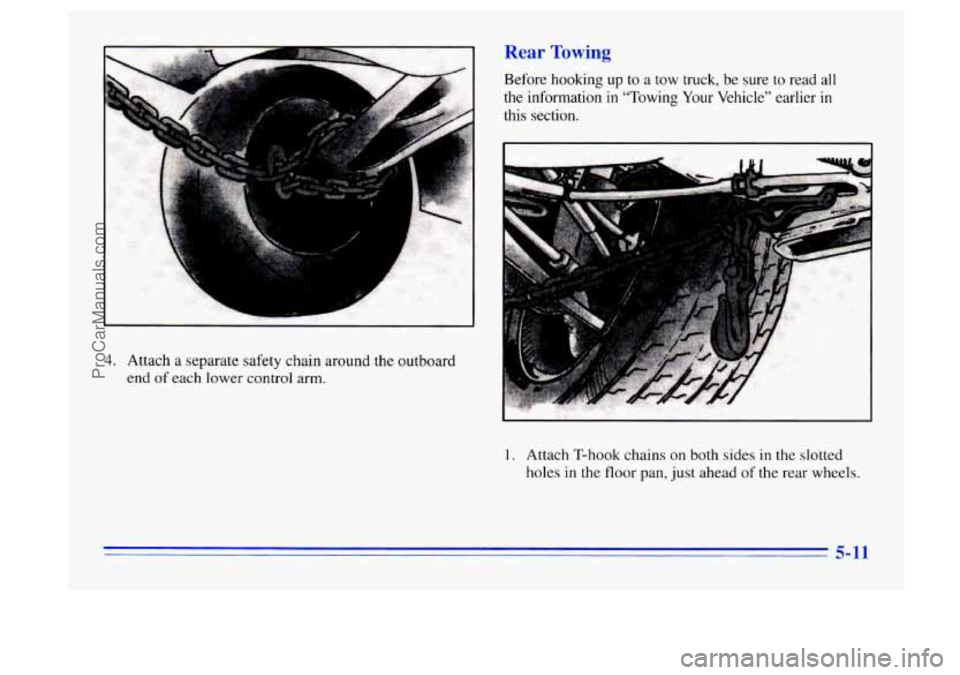
p.
F
4. Attach a separate safety chain around the outboard
end
of each lower control arm.
Rear Towing
Before hooking up to a tow truck, be sure to read all
the information
in “Towing Your Vehicle” earlier in
this section.
1. Attach T-hook chains on both sides in the slotted
holes
in the floor pan, just ahead of the rear wheels.
5-11
ProCarManuals.com
Page 178 of 340
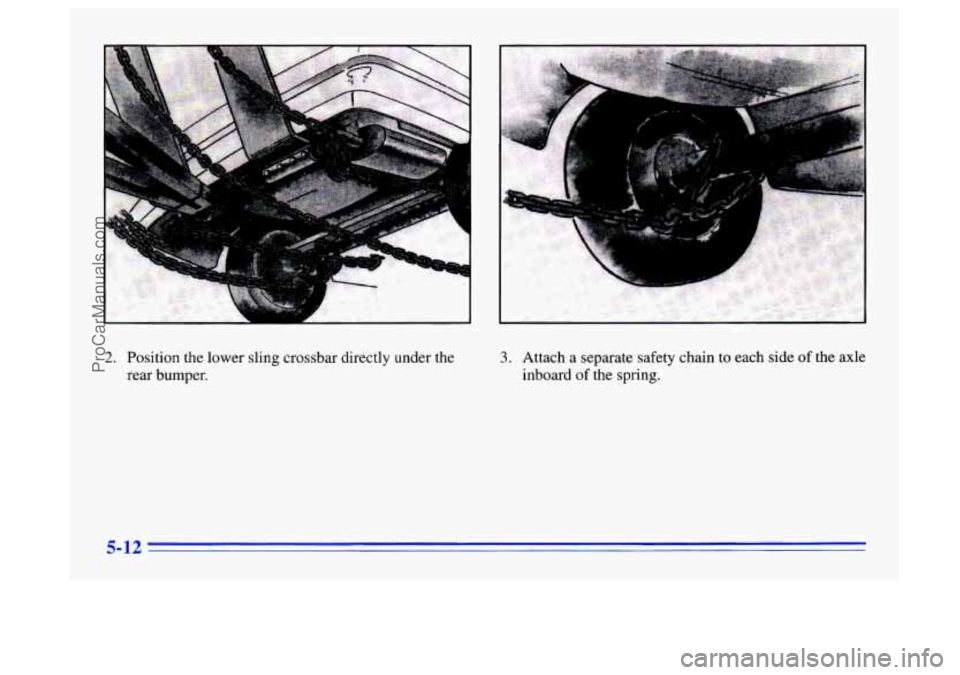
.. .
..
.
I"=--
I
2. Position the lower sling crossbar directly under the
rear bumper. 3. Attach a separate safety chain to each side of the axle
inboard
of the spring.
5-12
ProCarManuals.com
Page 179 of 340
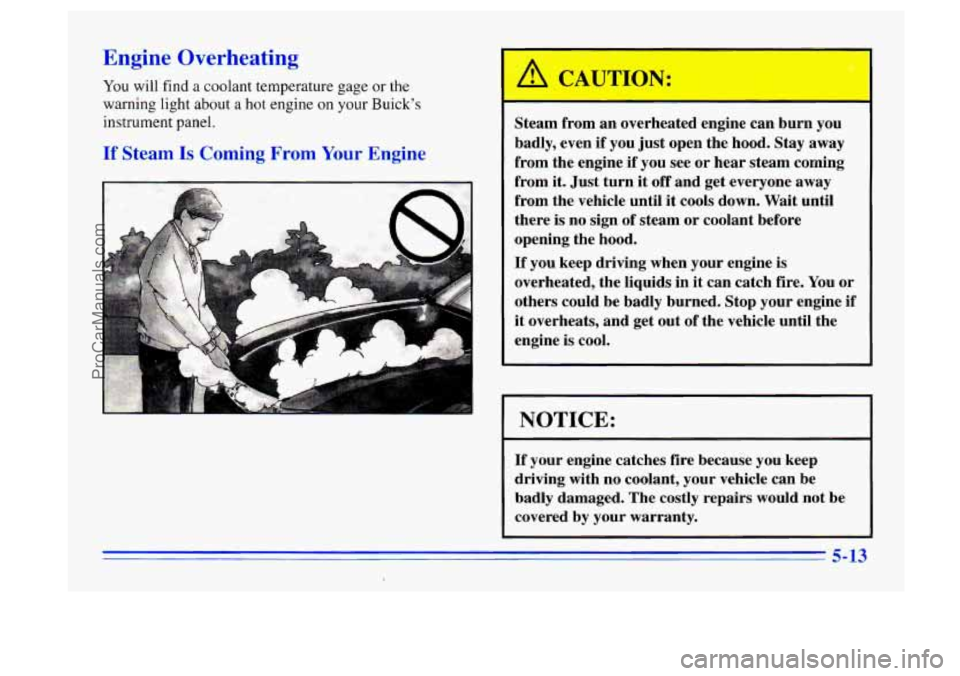
Engine Overheating
You will find a coolant temperature gage or the
warning light about a hot engine on
your Buick’s
instrument panel.
If St1 .-m Is 1 - - ng Fro Your Engine
Steam from an overheated engine can burn you
badly, even if you just open the hood. Stay away
from the engine if you see or hear steam coming
from it. Just turn
it off and get everyone away
from the vehicle until
it cools down. Wait until
there is no sign of steam or coolant before
opening the hood.
If you keep driving when your engine is
overheated, the liquids in it can catch fire. You or
others could be badly burned. Stop your engine if
it overheats, and get out of the vehicle until the
engine is cool.
NOTICE:
If your engine catches fire because you keep
driving with no coolant, your vehicle can be
badly damaged. The costly repairs would not be
covered by your warranty.
5-13
ProCarManuals.com
Page 180 of 340
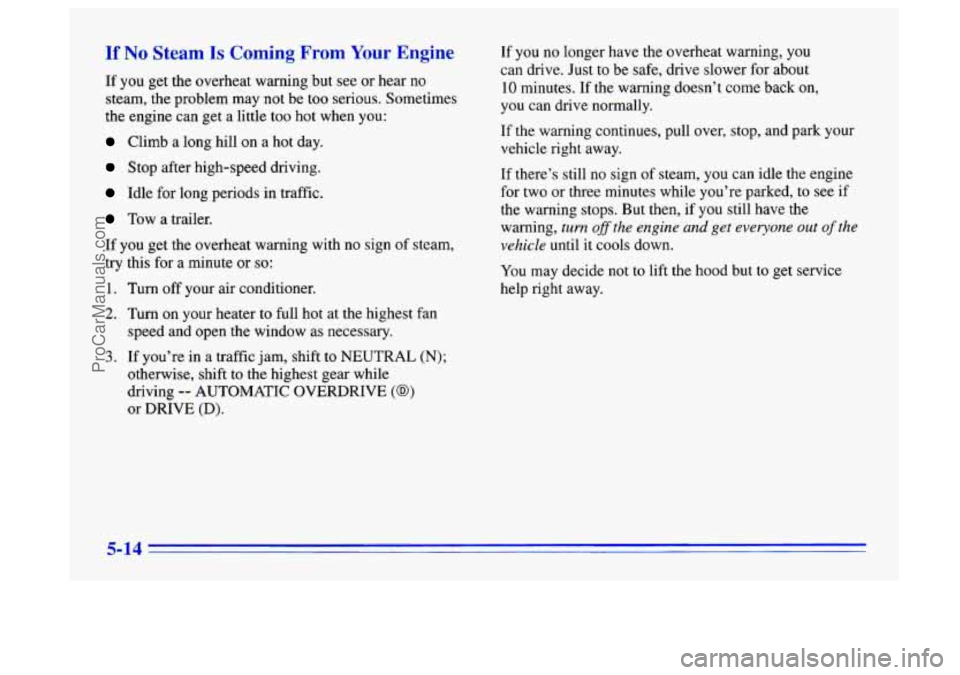
If No Steam Is Coming From Your Engine
If you get the overheat warning but see or hear no
steam, the problem may not be
too serious. Sometimes
the engine can get a little too hot when you:
Climb a long hill on a hot day.
Stop after high-speed driving.
Idle for long periods in traffic.
Tow a trailer.
If you get the overheat warning with no sign
of steam,
try this for a minute or
so:
1. Turn off your air conditioner.
2. Turn on your heater to full hot at the highest fan
speed and open the window as necessary.
3. If you’re in a traffic jam, shift to NEUTRAL (N);
otherwise, shift to the highest gear while
driving
-- AUTOMATIC OVERDRIVE (@)
or DRIVE (D). If
you no longer have the overheat warning, you
can drive. Just to be safe, drive slower for about
10 minutes. If
the warning doesn’t come back on,
you can drive normally.
If the warning continues, pull over, stop, and park your
vehicle right away.
If there’s still no sign
of steam, you can idle the engine
for two or three minutes while you’re parked, to see if
the warning stops. But then, if you still have the
warning,
turn ofthe engine and get everyone out of the
vehicle until it cools down.
You may decide not to lift the
hood but to get service
help right away.
5-14
ProCarManuals.com